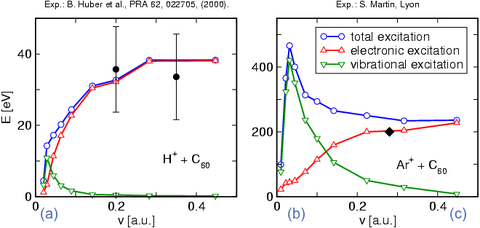Atom - cluster collisions
Table of contents
"Transparency" in atom - metal cluster collisions
The energy loss ΔE in Na9+ + Na collisions as a function of the (center of mass) bombarding energy Ecm clearly shows a minimum at intermediate Ecm around 1 keV. Obviously, the corresponding impact velocity is too large to excite vibrations and still too small to excite electrons and, thus, the atom penetrates the cluster nearly freely ("Transparency") [2].
Total kinetic energy loss of relative motion ΔE in central Na9+ + Na collisions for a fixed collision geometry (see inset) as a function of the center-of-mass impact energy Ecm calculated with NA-QMD (solid line) and QMD (dotted line). Vibrational and electronic contributions to ΔE are distinguished by gray and light-gray shaded areas, respectively (Figure taken from [2]).

The transparency effect results in a plateau of the fragmentation cross section as a function of the bombarding energy.
Total fragmentation cross section σfrag as a function of Ecm calculated with NA-QMD (solid line). The circles are experimental data (Figure taken from [2]).
"Stopping power" of H+ and Ar+ in collisions with C60

In the two figures, the calculated energy loss E of the particle as function of the (center of mass) impact velocity v is shown [1].
In the movies the (totally different) collision mechanisms are visualized:
- (a) H+ with v=0.05 a.u. is reflected (backward scattering).
- (b) Ar+ with v=0.05 a.u., however, destroys the cage completely due to pure vibrational excitations ("nuclear stopping power").
- (c) Ar+ with v=0.45 a.u. penetrates the cage freely without any vibrational excitation, but the cage is electronically highly excited ("electronic stopping power").
Electron-vibration coupling leads to excitation of a giant breathing mode.
- T. Kunert and R. Schmidt, Excitation and Fragmentation Mechanisms in Ion-Fullerene Collisions, Phys. Rev. Lett. 86, 5258 (2001).
- U. Saalmann and R. Schmidt, Excitation and Relaxation in Atom-Cluster Collisions, Phys. Rev. Lett. 80, 3213 (1998).

